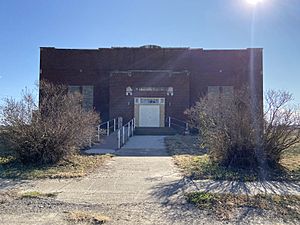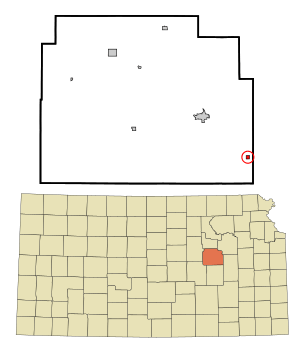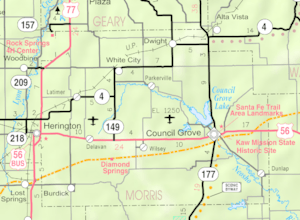Dunlap, Kansas facts for kids
Quick facts for kids
Dunlap, Kansas
|
|
|---|---|

Dunlap gymnasium on 5th Street (2019)
|
|

Location within Morris County and Kansas
|
|

|
|
| Country | United States |
| State | Kansas |
| County | Morris |
| Founded | 1870s |
| Incorporated | 1887 |
| Named for | Joseph Dunlap |
| Government | |
| • Type | Mayor–Council |
| Area | |
| • Total | 0.25 sq mi (0.64 km2) |
| • Land | 0.25 sq mi (0.64 km2) |
| • Water | 0.00 sq mi (0.00 km2) |
| Elevation | 1,188 ft (362 m) |
| Population
(2020)
|
|
| • Total | 27 |
| • Density | 108/sq mi (42.2/km2) |
| Time zone | UTC-6 (CST) |
| • Summer (DST) | UTC-5 (CDT) |
| ZIP code |
66846
|
| Area code | 620 |
| FIPS code | 20-18950 |
| GNIS ID | 477177 |
Dunlap is a small city in Morris County, Kansas, United States. In 2020, the city had a population of 27 people. Dunlap is known for its important role in the history of African American migration after the Civil War.
Contents
History of Dunlap
Dunlap was founded in 1869 by Joseph Gage Dunlap, who was an agent for the Kanza Native American tribe. A post office was first set up in 1874. The town grew slowly at first.
Benjamin "Pap" Singleton and the Exodusters
The town really started to grow when Benjamin "Pap" Singleton arrived in 1878. Singleton was born into slavery in 1809 in Nashville, Tennessee. He escaped to freedom in 1846 and helped other escaped slaves. After slavery ended, he returned to Nashville.
After the Civil War, newly freed slaves in the South faced many challenges. Their rights were not safe, and groups like the Ku Klux Klan caused fear and violence. A new system of farming called sharecropping and unfair laws known as Jim Crow laws made life very hard for African Americans. Singleton believed something had to be done. He knew Kansas was famous for its fight against slavery, so he chose it as a "promised land" for his people.
Singleton traveled across the South, encouraging groups of African Americans to move to Kansas. He led a group of 200 Black families to Kansas in the 1870s, forming "Singleton's Colony." He wanted people who were ready to work hard and be independent. In 1878, Singleton moved to Dunlap and decided it would be a new home for more freed slaves escaping the South. He spread the word with posters, calling Kansas "one of the finest countries for a poor man in the world."
Between 1877 and 1879, hundreds of people followed him to Kansas, settling in places like Dunlap. Dunlap became Singleton's biggest success, earning him the name "Father of the Exodus." After this first wave, nearly 20,000 more African Americans moved to Kansas. These people are known as the Exodusters. They arrived in large groups between 1879 and 1880.
Unlike Singleton's first group, many Exodusters arrived with very few belongings. The towns they moved to already struggled to support their own people, so this large number of new arrivals was a challenge. To help, the Kansas state government created the Kansas Freedmen's Relief Association (KFRA) in 1879. This group, started by Governor John St. John, provided help and resources to struggling African American families. This support helped them build better lives and become important parts of their new communities. Benjamin "Pap" Singleton passed away peacefully in 1900. He was proud that he had helped thousands find a better life in Kansas.
Growth and Decline
After Singleton's death, Dunlap continued to grow into the early 1900s. In 1880, the Freedmen's Academy was founded by Rev. John M. Snodgrass of the Presbyterian church. This school was created to give African Americans a good education. The church building later fell into disrepair.
When Singleton first brought many Exodusters to Dunlap, some of the original settlers were not happy. In the late 1800s and early 1900s, the newly freed slaves faced some unfair treatment. However, it was much better than the harsh conditions they had left in the South. While schools and businesses were sometimes separated, African Americans in Dunlap were able to own and run their own businesses and schools. They also had their own cemetery, the Dunlap Colored Cemetery, which started in 1894.
By the early 1900s, Dunlap was home to hundreds of people. It became an important shipping center for the nearby counties of Morris, Lyon, and Chase. Being close to the Neosho River meant the land was good for farming, which helped Dunlap grow. At its busiest, Dunlap had many businesses, including a blacksmith, a bank, several churches, an ice cream shop, a dairy factory, a hotel, and a flour mill. Even though some store owners at first would not let African Americans into their businesses, this separation eventually faded away. Dunlap began to integrate its stores and schools much earlier than many other places in the country.
Even though Dunlap was a "promised land" for African Americans escaping unfair treatment, it faced hard times in the 1930s. The Great Depression, a time when the economy was very bad, affected the town. The Dust Bowl also happened in the 1930s. This was caused by poor farming methods and led to huge dust storms across the country, making it hard to grow crops.
These problems caused many small farming communities, including Dunlap, to shrink. The last celebration of Juneteenth, a holiday celebrating the day slaves learned they were free, was held in Dunlap in 1931. Eventually, the bank closed, businesses shut down, and then the school and churches also closed. Many people left Dunlap to find better opportunities in larger cities like Kansas City. The economy eventually improved, but Dunlap never returned to its former size. It is now known as one of Kansas's many "ghost towns."
The post office in Dunlap closed in 1988, marking the end of Dunlap as an official city. Today, Dunlap is an unincorporated area of Kansas, meaning it's not officially a city anymore, and only about thirty people live there.
Dunlap Colored Cemetery
The Dunlap Colored Cemetery, also called the Exoduster Cemetery, is a very important historical site. It was created in response to the unfair treatment and separation faced by the Exoduster community. The cemetery was first established in 1880 and has over a hundred graves of African Americans. It was added to the National Register of Historic Places on September 14, 2018. This was done because of its connection to the Exoduster Movement and to "Pap" Singleton, who led many people to freedom.
Geography
Dunlap is located at 38°34′33″N 96°21′58″W / 38.57583°N 96.36611°W. The city covers about 0.23 square miles (0.60 square kilometers) of land. Dunlap is near the Neosho River, which has sometimes caused flooding problems in the past.
Climate
The weather in Dunlap has hot, humid summers and usually mild to cool winters. This type of weather is called a humid subtropical climate.
Population Changes
| Historical population | |||
|---|---|---|---|
| Census | Pop. | %± | |
| 1880 | 247 | — | |
| 1890 | 408 | 65.2% | |
| 1900 | 400 | −2.0% | |
| 1910 | 333 | −16.7% | |
| 1920 | 300 | −9.9% | |
| 1930 | 273 | −9.0% | |
| 1940 | 219 | −19.8% | |
| 1950 | 134 | −38.8% | |
| 1960 | 134 | 0.0% | |
| 1970 | 102 | −23.9% | |
| 1980 | 82 | −19.6% | |
| 1990 | 65 | −20.7% | |
| 2000 | 81 | 24.6% | |
| 2010 | 30 | −63.0% | |
| 2020 | 27 | −10.0% | |
| U.S. Decennial Census | |||
Dunlap's population grew after its founding, reaching its highest point in 1890 with 408 people. After that, the population slowly decreased over many decades, especially during the Great Depression. By 2020, only 27 people lived in Dunlap.
2020 Census Information
The 2020 United States census counted 27 people living in Dunlap. There were 15 households and 9 families. Most of the residents (85.19%) were White, and 3.7% were Black or African-American. About 11.11% of the population identified as being from two or more races.
Education
The public schools in Dunlap are part of the Morris County USD 417 school district.
See also
 In Spanish: Dunlap (Kansas) para niños
In Spanish: Dunlap (Kansas) para niños

